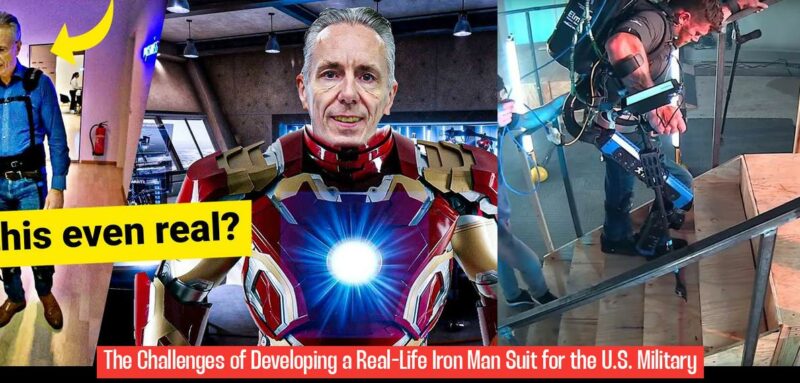Challenges in Designing a Real-Life Iron Man Suit
Ah, the elusive quest for a real-life Iron Man suit – a dream so close yet so far away. Picture this: the military gearing up to unleash their very own Tony Stark-esque creation, only to realize that maybe, just maybe, technology hasn’t quite caught up with Hollywood’s imagination.
So, why did the U.S. Military scrap its grand plans for the Iron Man suit? Well, let’s dive into the challenges they faced in designing this futuristic exoskeleton:
The main issue boiled down to one word: interoperability. Imagine trying to sync up all the components of a high-tech suit with perfect harmony – sounds tricky, right? That’s precisely what stumped the military in 2019 when they had to bid farewell to their Iron Man dreams. The level of synchronicity needed between various parts of the suit proved too complex to achieve.
ASOG Fact: Creating a real-life Iron Man suit isn’t just about slapping on some armor and calling it a day; it requires a delicate dance of advanced technology and seamless integration.
Now, here’s where it gets interesting. While we might not have full-fledged Iron Man suits cruising around just yet, advancements in exoskeleton tech and materials science are nudging us closer to that exhilarating possibility. So who knows? Maybe one day we’ll witness our very own superhero zooming through the skies.
But hey, don’t lose hope just yet! The journey towards creating an actual Iron Man suit may be long and arduous, but every small step counts.
Curious about more hurdles in crafting such high-tech gear? Keep reading ahead for further insights on why achieving an authentic Iron Man sensation remains a geeky night-time fantasy… or does it?
Technological Hurdles and Why the Project Was Scrapped
The U.S. Military’s ambitious plan for a real-life Iron Man suit hit a major roadblock due to technological hurdles that made the project more science fiction than reality. One significant challenge was the immense amount of energy required to power all the suit’s components efficiently. This need for exportable power sources capable of sustaining the suit’s operation untethered proved to be a formidable obstacle in bringing the Iron Man vision to life. While modern technological advancements have made strides in exoskeleton technology, creating a fully functional Iron Man suit still remains a distant dream.
Thinking about it, it’s like trying to charge your phone with a AA battery – just not enough juice for what you need. The military’s desire for a suit like Tony Stark’s was driven by its potential bullet and blast protection capabilities, along with the allure of untethered operation. It’s no wonder they wanted in on that super-powered action, hoping to leverage these suits across various branches in defense. But alas, despite Tony Stark being an undeniable genius, sharing his tech secrets wasn’t on his agenda.
In essence, as much as we’d love to zip through the skies like Iron Man, the reality check hits hard – our technological prowess hasn’t quite caught up with Hollywood magic yet. However, the gleam of hope rests in ongoing advancements within exoskeleton technology and material science nudging us closer to that fantastical possibility. So while donning an Iron Man suit may remain a distant dream for now, who knows what surprises tomorrow might hold? Until then, let’s keep our eyes on the horizon and marvel at how far we’ve come in chasing these high-tech dreams!
Future Prospects in Military Exoskeleton Development
Future Prospects in Military Exoskeleton Development:
The U.S. Military faced a significant setback when they had to abandon their plans for a real-life Iron Man suit due to the complex interoperability required between various components of the suit in 2019. One major challenge that emerged was the need for strong, lasting, and rugged mobile sources of electrical power to sustain all the suit’s operations efficiently – a crucial aspect that couldn’t be overlooked. Despite these technological hurdles, the possibility of creating an authentic Iron Man suit isn’t entirely off the table with advancements in technology.
Looking into the future, achieving a real-life Iron Man suit necessitates reaching a level of technology capable of providing robust and durable electrical power sources—an endeavor crucial for sustaining such high-tech gear’s demanding operational requirements. While challenges persist, notable progress has been made in exoskeleton technology and materials science, hinting at potential breakthroughs that could eventually pave the way for bringing Tony Stark’s superhero tech into reality.
Now, picture this: an actual Iron Man suit powered by cutting-edge technology that not only offers advanced capabilities but also promises unparalleled efficiency and versatility akin to Iron Man Armor Mark LXXXV—the zenith of Tony Stark’s creations. The dream of wearing an exoskeleton packed with mechanical and electronic components may not be just wishful thinking anymore with continuous innovation pushing boundaries closer towards making this fantasy step out from comic book pages into tangible existence.
So, as we eagerly anticipate what tomorrow holds in store for military exoskeleton development and ponder over whether we are truly on the brink of witnessing our very own superhero suits zooming through skies – let’s remember that every technological stride brings us one step closer to turning fiction into reality!
Why was the U.S. Military’s real-life Iron Man suit scrapped?
The exoskeleton was scrapped because it proved impossible to design to the intended SOCOM specifications due to the required interoperability with other components in the suit.
Can an Iron Man suit be made in real life?
While significant progress has been made in exoskeleton technology, a fully functional Iron Man suit is still far from being created. However, advancements in technology and materials science bring us closer to the possibility in the future.
What happened to Iron Man’s suit in the movies?
In the movies, Iron Man’s suit was destroyed during Stark’s escape in Afghanistan and later rebuilt. It was destroyed again in the attack on Stark’s house in Iron Man 3.
Why doesn’t the military have Iron Man suits?
The military does not have Iron Man suits due to the need for strong, lasting, rugged mobile sources of electrical power, which are currently not readily available for such advanced suits.



